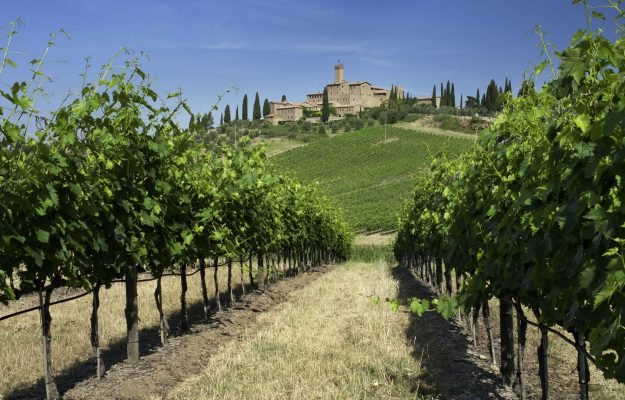One of the most important challenges that the winemaking world is facing currently and will continue to face in the future, is climate change. Wine especially is affected by “climate change” because the rise in temperatures is moving towards a “tropical climate” in Italy as well. The sector of the wine industry is not new to calls to intervene on responsibility, adaptation, research but also foresight to be prepared for changes. Brunello di Montalcino’s leading wine company, Castello Banfi, is well prepared and historically sensitive to innovations. In order to win the climate change battle, the company has decided to re-launch its commitment of experimenting with new vines, having the goal of achieving the “natural survival” of the plant. Their most recent research involves experimenting with 25 varieties of vines, hoping to offset “climate change”, which in Tuscany has brought more abundant rains as well as intense heat in the past few years.
Research has always played a leading role in the history of the company, and the challenge is already underway. Indeed, in the 1980s Castello Banfi, Professor Attilio Scienza and the winemaker Rudy Buratti, in collaboration with the University of Milan, carried out an experiment on 650 clones of Sangiovese, which helped to create a deeper knowledge of the vine in the wine world, furthering the knowledge starting in 2017 through the work of “Sanguis Jovis - Alta Scuola del Sangiovese”. Experiments on the new varieties started in 2016 in two vineyards in Montalcino, one and a half hectares each, exactly the same, but at different altitudes. The first vineyard on the plains while the second is on the hills. They were selected to be able to analyze the results in two different contexts.
“The objectives”, Gianni Savelli, agronomy manager of Castello Banfi, explained to WineNews, “are to find resistant varieties, and safeguard the environment as well as the workers in the vineyard, by adopting fewer treatments. The end consumer will benefit from all of this. Our research is focused on varieties resistant to major diseases. We have taken ten varieties from the Edmund Mach Foundation of San Michele all’Adige - with which we have been collaborating for years - two are registered in the national register (Iasma Eco 1 and Iasma Eco 2, ed.) and eight are in exclusivity that for the first time have been included in the open field. These choices were made to build an effective barrier against Botritis, thanks to the thick-skinned berries, but we are also looking towards new markets. We did not stop there, however, and instead went to look for new varieties that are not yet authorized in Tuscany. We are, therefore, experimenting with 25 varieties, 17 of which are black berries (including the Georgian Saperavi, which seems to give interesting responses, ed.) and 8 white berries. We are working to innovate”.
Castello Banfi is focusing on yet another requisite, which is “the rootstocks, whose research stopped in the twentieth century. We have included four of them”, continued Savelli, “we want to develop this aspect, too. When will we get the first results? The 2020 harvest will coincide with the first year of studies. Then there will be three mandatory years of standard checks and verifications, upon which we will make our assessments and decide whether it is appropriate to request registration in the national or rather the regional register”.
Copyright © 2000/2025
Contatti: info@winenews.it
Seguici anche su Twitter: @WineNewsIt
Seguici anche su Facebook: @winenewsit
Questo articolo è tratto dall'archivio di WineNews - Tutti i diritti riservati - Copyright © 2000/2025









































































































































































































